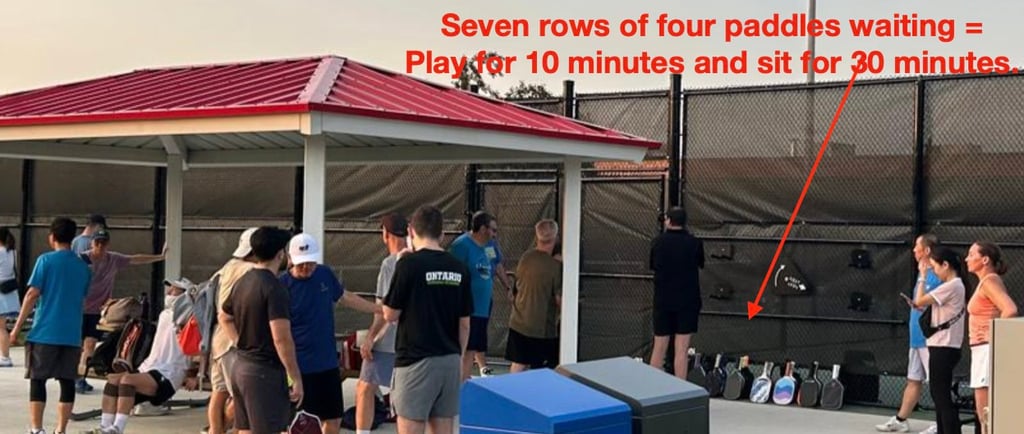What’s Needed: Courts + Clubs
Richmond Hill’s pickleball community is growing fast — but the City’s approach hasn’t kept up. This post explores why dedicated pickleball courts and strong community clubs are essential to managing growth, welcoming new players, and building a thriving, inclusive pickleball culture. It explains why “a few courts here and there” won’t work, how cities like Newmarket got it right, and why Richmond Hill needs to listen to the players and clubs who live the game every day.
PAG
7/9/20253 min read


What’s Needed: Courts + Clubs
Why Pickleball Hubs and Dedicated Courts Matter — and Why Community Partnerships Are Essential to Growth
Pickleball is thriving in Richmond Hill and across Canada — but the infrastructure to support it hasn’t kept pace. Every week, more residents discover the sport’s unique blend of fun, fitness, and friendship, only to find that there are too few places to play and limited opportunities for structured play or instruction.
In 2020, Richmond Hill built 2 dedicated courts at King's College Park and in 2025, they opened 4 new courts at Bayview Hill Park, both located close to nearby residents, drawing complaints about noise and parking. At Bayview Hill, they permit one of the 4 courts to be booked online, which has been controversial and led to disputes and long wait times. Another growing issue with these courts is existing players connected online are dominating use, creating an unwelcoming environment. They added some temporary options — lined tennis courts, marked arena floors, and outdoor spaces that serve as short-term fixes. While these efforts help introduce the sport, they are not long-term solutions to the problem. To truly support growth, the City needs a coordinated plan that provides dedicated, purpose-built pickleball courts and strategically located hubs where players can gather, learn, and play together.
Why Dedicated Courts Matter
Pickleball differs fundamentally from tennis — not just in court size, but in how people play, socialize, and engage.
Games are shorter, with players rotating frequently.
Courts serve larger groups who mix and play with new partners.
The sport thrives in central “hubs,” where dozens of players can meet others of similar skill levels, join round robins or leagues, and develop friendships.
When only a few courts are scattered across the city, play becomes fragmented. This leads to long waits, inconsistent experiences, and in some cases, frustration for newcomers who struggle to find organized opportunities to play.
Purpose-built pickleball hubs — typically 10 to 20 courts — solve these challenges. They allow for coaching, leagues, lessons, and open play to coexist in one well-managed space. This model is already working in several Ontario communities.
Newmarket is one of the best examples. With a population of just 93,000, the town has invested in six dedicated courts at Quaker Park, six shared-use courts with portable nets at Joe Perchini Park, and soon, a 20-court indoor complex at the south end of George Richardson Park. Newmarket’s success came through collaboration between city staff and organized user groups, resulting in a vibrant, inclusive pickleball community where players of all levels feel welcome.
The Role of Community Partnerships
Sustainable growth in pickleball depends on communication and cooperation between municipalities and user groups. Local associations and community organizations already have the infrastructure — from player networks and volunteer bases to coaching programs and communication tools — that cities can leverage.
These groups help:
Introduce new players through lessons, clinics, and social events.
Organize structured leagues and ladders by skill level.
Foster sportsmanship, inclusion, and mentorship.
Provide valuable feedback on facility design, scheduling, and community needs.
Municipalities that collaborate with organized user groups benefit from local knowledge, established systems, and trusted community relationships — often saving significant costs on consultants and administrative overhead.
Lessons from Newmarket and Beyond
Newmarket’s model shows what can happen when a municipality and its players work together. Instead of relying solely on studies and surveys, staff engaged directly with the pickleball community to shape a plan that worked for everyone. The result is an efficient, cost-effective system that supports recreation, social connection, and lifelong fitness.
By comparison, larger municipalities often turn to repeated studies and consultant reports before acting — an approach that delays progress and can leave residents waiting years for meaningful results, as we have witnessed in Richmond Hill. The key takeaway from successful communities is clear: collaboration and communication are far more effective than consultation alone.
A Smarter Way Forward for Richmond Hill
Richmond Hill can position itself as a leader in active living by embracing a forward-thinking pickleball strategy that combines dedicated hubs with strong partnerships.
Working directly with user groups would help the City:
Identify real player needs and participation trends.
Design courts and programs that maximize usage and inclusion.
Offer well-organized play without additional staffing costs.
Build confidence among residents that public funds are being spent wisely.
This collaborative approach delivers better outcomes for players and taxpayers alike.
Conclusion
Pickleball’s growth is not a problem to solve — it’s an opportunity to seize. With proper planning, dedicated facilities, and genuine collaboration with community partners, Richmond Hill can create an inclusive recreational model that serves thousands of residents, promotes health, and strengthens community connection.
The next step is simple: bring players, user groups, and City staff to the same table. Together, we can build a Richmond Hill that plays — and grows — through pickleball.
